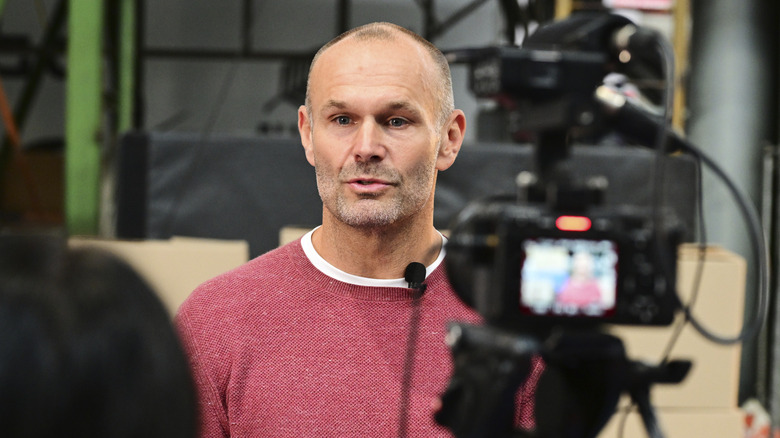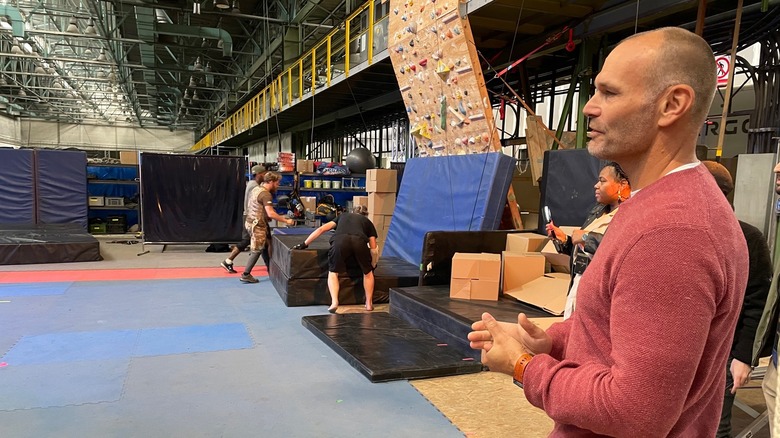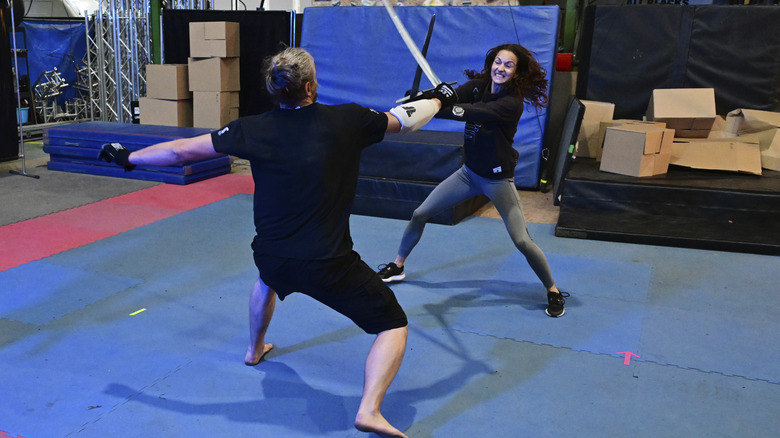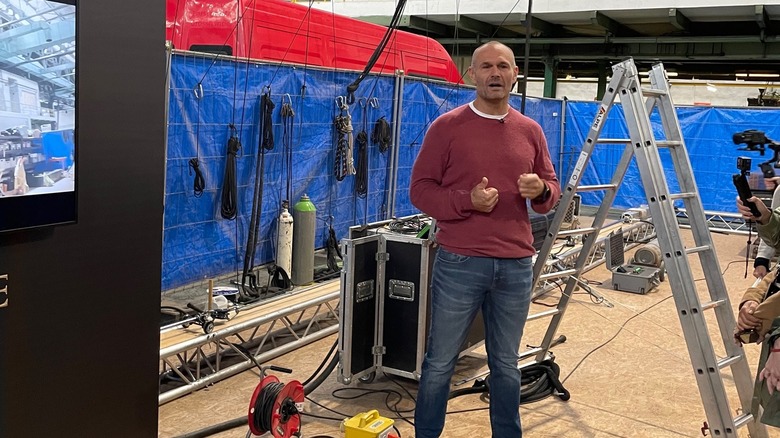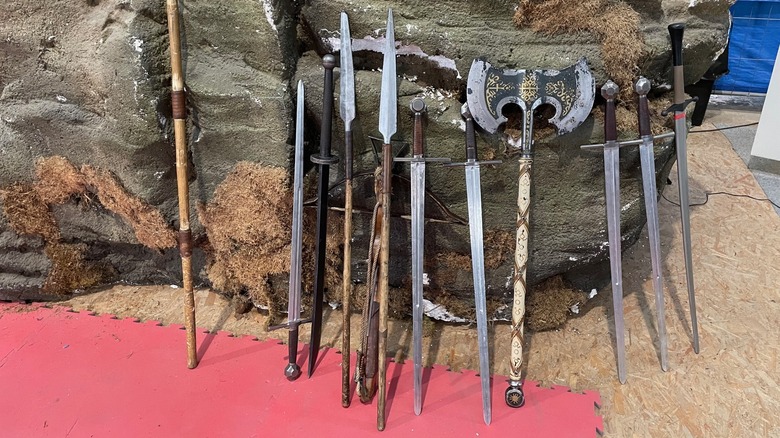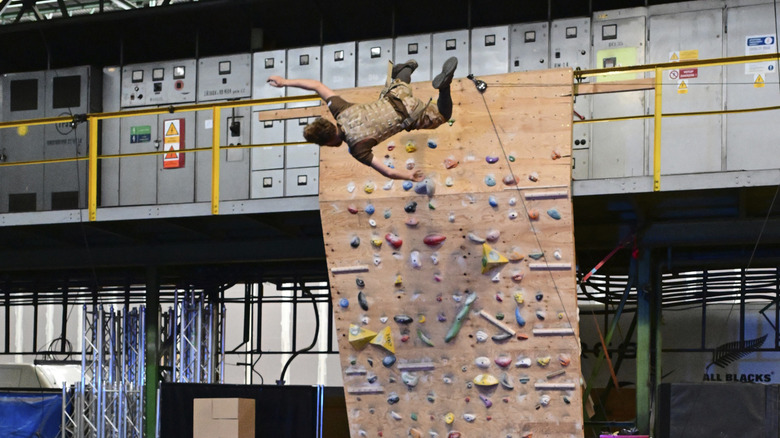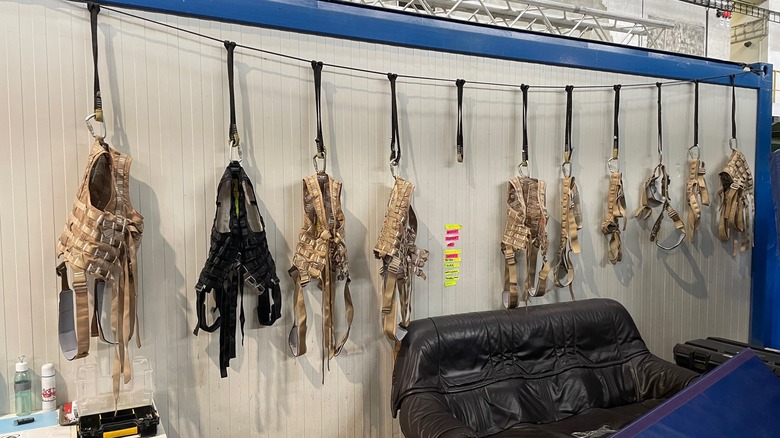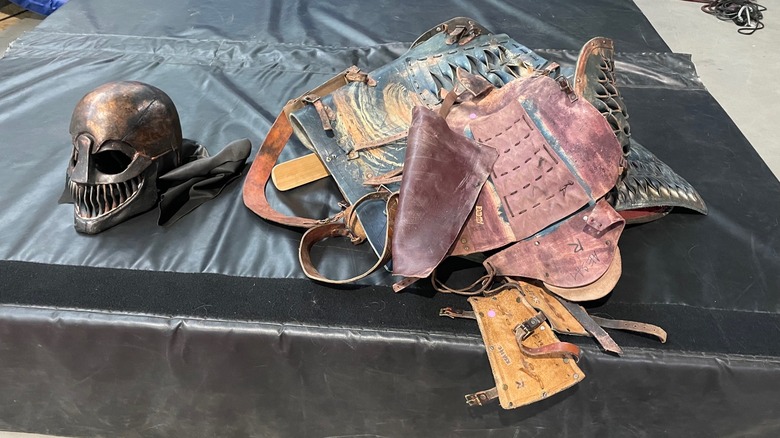Wheel Of Time's Jan Petrina Teases A Big Finale & Wild Behind-The-Scenes Secrets - Exclusive Interview
"The Wheel of Time" is a massive show that has set itself the herculean task of adapting Robert Jordan's 14-book fantasy epic into an eight-season show. Season 1 spent much of the time introducing locations, establishing characters, and getting things in motion. Now, Season 2 is amping up the energy. In the first few episodes alone, there are numerous uses of the One Power, duels between soldiers, and other action-packed elements, all of which require coordination and training.
That's where Jan Petrina comes into the picture. The series stunt coordinator has an impressive resume that includes working as a stunt double on multiple MCU films ("Captain America," "Guardians of the Galaxy," and "Avengers: Age of Ultron," just to name a few). On the "Wheel of Time" set, though, Petrina has stepped into the role of coordinator, and he oversees the development of numerous fights, duels, battles, and stunts for the show.
Looper was recently invited behind the scenes to see some of Petrina's crew recreate stunts from Season 2. Along with some snazzy behind-the-scenes footage, we also had a chance to talk to Petrina about what goes into creating the action sequences for Robert Jordan's world. This begins as a stationary interview, but halfway through, we started moving around the stunt stage with the coordinator, asking questions about weapons, harnesses, armor, and more as we went along. The pictures help shed further light on Petrina's already insightful answers.
Prep time and actors doing their own stunts
How many of the actors do their own stunts, and do you have any other stunt people on the set?
We've got a lot of the cast members doing a lot of the stunts, a lot of the fighting for themselves. That's what we aim for, and that's always what the directors like. We need to draw a line when it becomes too dangerous, and especially with wire work and them flying and hitting the ground. There [are] some limits, but most of the fighting is done by the majority of the actors.
How much time do you get with them before they film the final scenes?
It is very individual. Some of them are very busy, and they get a lot of commitments, so they come at the last moment. What we try to do, we try to design the action, do a video of a slow motion and walk through the action, and we send it to them so they can start practicing on their own. When they come, they know the moves, and then we put them straight in, and then they practice a little bit more with us. Some of them that are available, around six weeks before we start shooting, most of them need to keep practicing through the whole production. It's like 10 months of hard work for them.
With "Wheel of Time," there is a lot of sword fighting, and I know there are a lot of characters that are very good at fighting with swords in the books. How does choreographing those scenes — making them safe, making them look cool — how does that look?
We worked with most of them already in Season 1, so you know what they've been through, their strong moves, what they prefer. You build on top of what we did in Season 1.
For example, Daniel [Henney], he's got a lot of experience of action from earlier in his life, and he's super fit. He comes in, and it's a lot easier for us to work with someone who already knows, so we can straight to the choreography. He comes with ideas that he thinks he likes, and he knows what he can actually do himself. He helps us. With some of the new members coming in first, we go through assessments, we see how fit they are, what their strong moves are, and we try to build the choreography and the style that enhances what they already know and what is comfortable for them.
Developing actor skills to match character arcs and using the One Power
Some of the characters develop their skills as they go. Do you take that into account and have them do more complicated things each season?
Yes, that's the aim, and that's the big difference from Season 1 and Season 2. In Season 1, you met a lot of kids in Two Rivers that maybe went hunting, but they've never held a sword in their hands. Now, Season 2, you see them, and they're supposed to already be going through some fights, and they're becoming leaders, and they're becoming heroes. They got some skills.
On the other side, swords are physical. What about stunt coordinating in a show where there's the One Power element impacting a lot of these things? How has that affected coming up with stunts?
For us, all the Aes Sedais, they need to go through some movement training. We've got Scarlett [Mackmin, choreographer], and she's the one who comes up with a lot of the movement and most of the movement for Aes Sedais. She helps us when we create the choreography, we do the damage, what the Aes Sedai does.
We'll say, "Okay, this is going to explode, this is going to fall, this person's going to fly." What the Aes Sedai needs to do prior to cause that effect, we leave it with Scarlett, and she goes to a training with the actors. Later on, when it's all created, we work together.
Favorite moments from Season 2 and actors who do the most stunts
In Season 2, is there a particular stunt that you're excited for people to see or an episode that you're particularly proud of?
A lot of them, and it's so busy that I cannot really point out one. I's nice to see again later on the season the Aiels coming back, because we've seen a little bit of it with Season 1.
It's quite nice, and also to see Loial fighting, because we haven't seen him fighting before. Daniel, Lan, step[s] up and us[es] two weapons instead of one. You can see the progression of each character doing a little bit more. It's all exciting, all in one big piece. The finale, it's great because there is all of them at once. That was challenging.
Out of all of the characters or actors, who's in here doing the stunt stuff the most?
They're doing quite a fair bit, of all of them. We need to, for some safety reason, if we see there's some prior injury, we say, "Okay, let's not do this." A lot of the kids, like Marcus and Dónal, they always want to do more and be better than the other ones. It's quite nice. They all do most of it.
Checking out the weapons on set
All right. Can we walk around a little?
Yeah, we can.
We've got a lot of the weapons here. How do you handle being safe and, at the same time, looking realistic with a lot of these?
A lot of it comes through the props [department], who makes the weapons and stuff. They come with the real weapon, and that's where we start. They see the design, and Rafe [Judkins, writer] and the director say, "We like that, so let's go with that." From that, they make molds, and they start making lighter versions for us and for the cast.
Some of them are rubber versions. We can also do, if you horse ride or if you need to run or jump or something, if you accidentally fall on the weapon, you don't injure yourself. If you do a big battle and swing around [among] a hundred people, you don't want to have something that is sharp accidentally hit someone that is behind you.
You do different versions of the weapon. You get plastic ones, and you get rubber ones, and yeah, very soft ones. Some of them are made from bamboo, but they're not sharp. That way, you can hit hard, but they're light enough. When you move them, you don't notice that it's not sharp. It is safer.
That's not very heavy at all. That's cool, but it has enough weight that you can swing it.
It has enough that you can definitely break bone if you don't do things correctly. That's why we need to do a lot of practice with everyone and then go through the routines again and again. Sometimes, it probably becomes boring. We say, "Let's do it again, do it again." They come day by day, and it's weeks and months, but at the end of the day, it does pay off, because on the day when you need to do things and then you need to sometimes adjust, make the fights shorter, it helps.
Athletic standards for the actors
Do you have athletic standards that you try to keep as well to make sure that everyone can perform these stunts properly?
We do. We go through physical training as well. We do warmups and stretching, and we see, for example, Hammed [Animashaun] playing Loial, wearing all the makeup, and the suit is heavy. He needs to also concentrate not only on the fighting skills but also on being physically fit. You can see his progression because it was also a new thing for him.
Getting used to the costume and the heat and all that stuff is hard. Coming to Season 2, he already knew what was coming, so he was working a lot harder, getting a lot more fit. You could last longer, especially in different locations that we had in Morocco with the sun and everything. It's like being in a sauna all day. It's physically demanding.
Hiding harnesses and clunky costumes
With the harnesses, how do you get these to not be seen? Some of these costumes are so thin.
It's the work of Sharon [Gilham] in the costume department. Sometimes, e make them upset because we destroy things, and we make them look bad because we need to squeeze things in there. These are the full harnesses that we use for a lot of the flying back and stuff.
When we use the actors and cast, we use some of the smaller ones when we can. We adjust the moves and the speed of the pulls. For the white shirt, we have this one, and we cover it with the skin color fabrics. We do the stunt [people], but then the cast version is smaller.
Those are more for helping with moves, whereas this is —
Helping and stunts. We can do some of the pulls with those, but it needs to take the edge off and slow down. That allows the costume to still look nice, because it's smaller but less comfortable. It's a compromise.
With the armor, this has got to be difficult to learn a move and then put all this on and then do the move.
Yeah, you can try, that's part of it. There is still more. There's belts, and then there's boots and a helmet, and you have that for 10, 12 hours a day and sometimes in the rain and then you run and fight. It is hard work, and some of the [main] actors need to wear it as well.
Executing stunts with a helmet on
Does anyone struggle with the helmets where you have to see what you're doing?
Yes, the vision is a little bit limited, and you don't see what's under you. Sometimes you can swing around [to see that] you've got another hundred people in the battle.
You were saying earlier that when everyone practices moves, and then they put on the same looking thing, and everyone has to understand, is there any way that you mark each person, or do they just have to remember?
You do a little sign. Sometimes you just scream. You say [something] because you don't see. Sometimes they let the actor know, "I'm the one that you're supposed to attack first," and then [someone else says] "I'm the second one." If you look at a hundred people like that, who do I hit first? You get 10 of the actors, and then they start fighting [to find out where their mark is].
Sometimes, [actors in the battle scenes] run in, and they slip by accident or trip over someone, so they're no [longer] there. Suddenly, it falls apart, [creating confusion for where someone has to go next]. It's quite fun at times, but it is hard.
Having done this now and immersed yourself in this world, do you have a favorite part of the world that you love? Having worked on the set now?
Because we've spent most of the production time in Czech Republic, it's always nice to go to new places. Last year, when we went to Morocco, it was nice to see the nature there and the different scenery. I like those things. It's very exotic.
New episodes of "Wheel of Time" premiere Thursday nights/early Friday mornings on Prime Video.
This interview has been edited for clarity.
